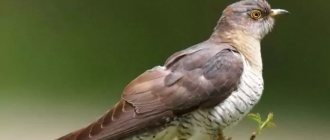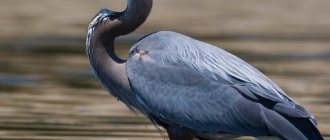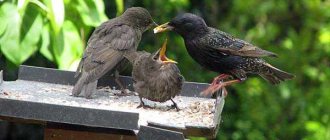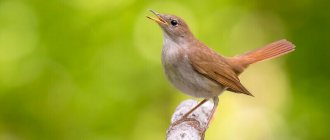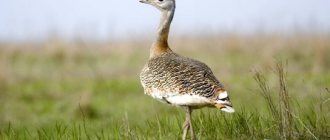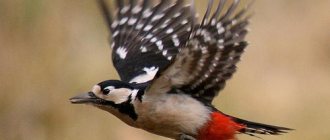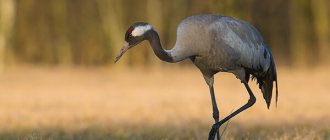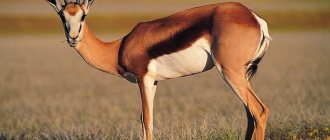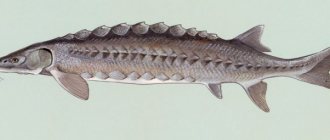Description of the bird
— Advertising —
This is what a nightingale looks like on earth
The most famous songbird in the CIS countries is the nightingale from the flycatcher family of the passeriformes order. Despite their wonderful voice, nightingales are not distinguished by their external beauty.
Appearance
In the photo: a nightingale sitting on a branch
A common representative of the species - the common nightingale weighs 25 g, body length in males and females - 16-17.5 cm, wingspan 24-27 cm. The plumage color of the common nightingale is olive-brown, the tail and wings are darker , and the abdomen is lighter, the sides are gray, the beak is small, yellow. The nightingale looks quite ordinary, more like a sparrow than a bird with an outstanding voice.
Nightingale – photo
Of course, the nightingale is not the most noticeable and colorful bird in the world. But we hope that thanks to our selection you will definitely not confuse him with anyone else!
Photo: matushka-priroda.ru
Photo: fotokto.ru
Photo: zen.yandex.ru
Photo: nat-geo.ru
Photo: photocentra.ru
Photo: stihi.ru
Photo: bryansknovosti.ru
Photo: funart.pro
Photo: erbirds.ru
Photo: sibirds.ru
Photo: sibirds.ru
Photo: photosight.ru
Photo: funart.pro
Photo: bryansky-les.ru
Photo: photocentra.ru
Photo: animalreader.ru
Photo: za.pinterest.com
Photo: sbbot.org.uk
Photo: densegodnya.ru
Photo: foto-tula.ru
Photo: erbirds.ru
Photo: photosight.ru
Photo: interesting-information.ru
Did you like the post? Subscribe to our channel in Yandex.Zen, it really helps us in our development!
What do they eat?
— Advertising —
This is what a nightingale looks like in flight
Nightingales feed on worms, earthen insects, spiders, and ant eggs. In summer and autumn, nightingales add berries to their diet. In captivity, bone meal, shells, feed yeast, hamarus, cottage cheese, chicken eggs, and sunflower seeds are used as substitutes for natural food for nightingales. Nightingales also eat walnuts, boiled meat and millet, fruits, berries and vegetables.
Nutrition
The nightingale's nightlife is devoted to singing, and its daytime life is devoted to searching for food. He runs along the ground, rakes leaves and heaps, takes out caterpillars, bugs, worms, spiders, larvae and other living creatures. The nightingale is a dexterous bird, so it can catch prey in flight. In summer, the bird's diet is replenished with ripe berries and fruits; the nightingale especially likes elderberry.
By autumn, the nightingale's feeding becomes more intense, as the bird tries to stock up on fat for the long flight to wintering.
Interesting! The nightingale feeds on insect pests that harm foliage and trees, thus saving plants from death, doing a great service for all humanity.
Nightingale bird. The photo does not convey the singing, but at the end of the article there is a video with a wonderful performance of the nightingale
Where does he live?
This is what a nightingale looks like while singing.
The nightingale's distribution range is wide. Birds are found in Europe, Western Asia and the Yenisei. Nightingales winter in Africa. For nesting, they prefer bushes or forest edges located near bodies of water, as well as groves, gardens and parks.
Range, habitats
The nightingale, due to its wide distribution in England, is considered an English bird. These singers are a common sight in forests, parks and playgrounds. Nightingales are also found in other countries such as Portugal, Spain, Persia, Arabia, Austria, Hungary and Africa. Breeds in Europe, North-West Africa, the Balkans and south-west Central Asia; Winter in sub-Saharan Africa, from West Africa to Uganda. This singing bird is the national symbol of Iran.
The nightingale prefers low areas tangled with thickets of deciduous forests . Thickets of bushes and all kinds of hedges are a suitable place of residence for the nightingale. But to a greater extent, the nightingale is a low-lying bird.
Nightingales inhabit many areas near rivers or swimming pools, although they can also live on dry hillsides, in low bushes among coastal sand dunes. When singing during the day, the nightingale often changes its location, but night songs are usually staged from the same positions. He sings in two three-hour arias at night. The first aria ends around midnight, and the second begins early in the morning.
Return to content
Migratory bird or not
This is what a nightingale looks like in flight.
The nightingale is a migratory bird. Migration begins in mid-August and lasts until mid-October. The nightingale flies to southern countries for the winter. Winters in Africa, south of the equator, but not north of southern Ethiopia. Nightingales fly to their native lands in the spring from mid-April to early May.
Lifestyle
This bird is in no hurry to return from its wintering place. The nightingale arrives in the spring, when the trees are already covered with greenery, and insects lead a vibrant life, since they are the food for these birds. Typically this time falls at the end of April to mid-May. Experienced singers are usually the first to return. After a few days, the one-year-old birds arrive. With their arrival, life changes. Young mature individuals tend to settle near experienced, old nightingales. They are trying to conquer part of the territory of those males who live here from year to year. But he actively defends this area. The old nightingale vehemently tries to drive away all the envious people and only gives in to some, conceding part of its territory. But at the same time, he himself decides who to give in to, as if he chooses with whom he wants to be neighbors. The matured young nightingales become new neighbors; the old ones will never be able to occupy someone else's territory.
In this way, a hierarchy of a small number of nightingales is formed.
The head is the oldest male, there are also from 1 to 3 adults, and the rest, the youngest, stand lower, subordinate to the leader. All of them can create families and settle at a distance of 15-30 meters, sometimes the neighboring nest is only five meters away. In such cases, the old and young nightingales can sit on the same branch and sing. At the same time, the younger bird strictly observes its turn to start singing. It happens that an inexperienced male gets carried away and begins to sing earlier, then the old bird attacks and drives away the intruder or begins to sing as loudly as the young one cannot yet, thereby silencing him. If the males live a few meters away from each other, each is given his own time to sing. This is usually observed in places that are particularly favorable for nesting. Here there may be no leader among the adult males. Also, eastern nightingales, which are only a year old, can group and live separately in settlements. These birds sing ineptly, with wheezing and blots, or overly zealously, with “heat.”
In other areas, usually further north, individual pairs settle at a distance of several hundred meters from each other.
Kinds
Today, ornithologists track 14 species of nightingales, which differ in external characteristics, singing abilities and habitat. In this article we will talk about the most popular nightingales in the CIS according to search queries.
Common Nightingale
Common or eastern nightingale
- Latin name : Luscinia luscinia
- Weight : 24 g (large adult bird)
- Highest classification : Nightingales
- Conservation status : Least Concern
Common Nightingale (Eastern Nightingale) - This species has the largest population in the nightingale genus. The bird's plumage is warm brown with a characteristic gray-brown pattern of spots on the chest. In the wild, the lifespan of the common nightingale is 8-10 years, some nightingales live up to 12 years.
Western or southern nightingale
The size of this species reaches the size of a sparrow. The belly and chest of the birds are gray-yellow, the plumage of the back and wings is brown with an olive tint. There are no patterns on the chest, thanks to which the species can be distinguished from the common nightingale.
Rubythroat Nightingale
- Latin name : Luscinia calliope
- Weight : 20-30 g (large adult bird)
- Highest classification : Calliope
- Conservation status : Least Concern
The Ruby-throated Nightingale is a small bird with a light breast and an olive-brown back. A characteristic feature of the male of this species is the red plumage of the throat. These birds sing loudly, but their song is shorter than that of an ordinary nightingale.
Red-breasted Nightingale
- Latin name : Tarsiger hyperythrus
- Weight : 11-16 g (large adult bird)
- Body length : 12-13 cm
- Highest classification : Nightingales
- Conservation status : Least Concern
The male red-breasted nightingale is handsome with an orange belly and a blue tail and wings. The body length of this species is about 13 cm, weight – up to 16 g. This species is widespread in the Himalayas, India, China, Bhutan, and Myanmar.
Blue Nightingale
The blue nightingale is a small species (about 15 g) with a pronounced difference between females and males. Males have blue-black plumage on the back, brown wings, black beak and cheeks, breast and abdomen are pearl-gray. Female blue nightingales are similar to females of the common nightingale. Sometimes their color has a blue tint. But the song of blue nightingales sounds simpler.
Reproduction
After the females have arrived, mating games begin. Males compete in the skill of singing, thus attracting ladies. It also happens that couples stay together since last year. When the time comes for mating, the male climbs deeper into the bushes and courtes his chosen one, flapping his wings and tail, until she deigns to let him come to her. Such is the female lot of nightingales that after mating she has to build a nest alone while her partner gets food.
Building bird nests is like building a house - a real art. The nightingale's nest is cup-shaped, it is located on the ground or on small bushes and consists of dry leaves that have been lying around since last year. The inside of the home is lined with thin and dry blades of grass and twigs
Male and female: main differences
Sexual dimorphism in nightingales differs depending on the species. For example, females and males of the eastern and southern nightingales practically do not differ from each other. But the males of the blue, red-breasted and ruby-throated nightingales have bright and noticeable plumage.
How nightingales prepare for mating season
During the breeding season, birds usually return to the same nest year after year. The male performs mating rituals, sings soft songs for the female, flaps and flares his tail, and sometimes lowers his wings. Sometimes during the rutting period the male chases the female, at the same time uttering pitiful sounds “ha-ha-ha-ha”.
Then the groom lands next to his chosen one, sings and dances, lowers his head low, flares his tail and trembles his wings.
During the fertile period, the female receives food from the contender for the heart. The partner also “guards the bride,” following her wherever she goes, sitting on a branch directly above her and observing her surroundings. This behavior reduces the likelihood of competition with other males for a female.
Keeping at home
Thanks to their sonorous voice, nightingales often become pets and favorites. However, you should pay attention to the fact that birds do not adapt well to captivity and may behave restlessly at first. If a bird fights in a cage, then cover the cage with thick cloth and try to disturb the nightingale as little as possible until it calms down.
Cage requirements
The minimum size of a cage for keeping nightingales is 40x60x30 cm. The smaller the cage, the greater the chance that the bird will develop obesity, which leads to death. The inside of the cage is equipped with a bird feeder and water bowl. The bars and jumpers in the cage must be wooden. In captivity, nightingales live up to 5 years.
What to feed the nightingale?
Insectivorous nightingales are demanding on their diet. To ensure that nightingales do not lack nutrients in captivity, they are fed flies, mealworms, crickets, and ant eggs. Plant components are gradually added to animal feed. For example, berries, fruits or vegetables. However, insects cannot be excluded from the nightingale’s food. It is worth noting that if a bird has stopped feeding for at least two days in captivity, then the nightingale should be released in order to save its life.
Is it possible to breed nightingales in captivity?
The photo shows the eggs of a nightingale.
Due to weak sexual dimorphism, it is difficult to choose a pair of nightingales. If this is successful, then such a pair is placed in a large aviary, a lot of material is left for the nest (grass, leaves, moss, bark) and the birds are provided with peace. In one clutch, a female nightingale has from 4 to 6 eggs, which she incubates for two weeks.
This is what nightingale chicks look like
Nightingale chicks fly out of the nest at 10-12 days, and their parents continue to feed them for another 10 days.
What to do if you find a nightingale chick
If you find a nightingale chick that has fallen out of its nest near a tree or bush, then you should not immediately pick it up. Pay attention to the nest; if it is not destroyed, then do not panic. In order to make sure that everything will be in order, and the chick’s parents will find it and accept it, it is worth observing the chick. When the hungry nightingale starts screaming, the parents will hear the scream and fly in. If you see a destroyed nest, wait more than 2-3 hours, and the parents do not arrive, take the chick home and try to feed it.
What to feed a nightingale chick
Padovan food for insectivorous birds is suitable for nightingale chicks. Suppress the food in a cup and give the already suppressed food to the chick. Live insects are also suitable, but there are cases when a bird is poisoned by insects or worms stored in stores and this leads to its death. Recommended food: padovan + mashed eggs (mashed eggs - eggshells).
Natural enemies
In addition to the fact that nightingales are hunted by large birds of prey, ferrets, martens, weasels and other nosy animals pose a serious threat to them. Because the nests are so close to the ground, they are often robbed.
Photo: erbirds.ru
Admiral butterfly (60 photos): description, species and habitat
Interesting Facts
- In Russia, the city of Kursk on the street. Pionerov, 84-a there is a museum “Kursk Nightingale” dedicated to the symbol of the Kursk region;
- John Milton's sonnet "To a Nightingale" (1632–33) contrasts the symbolism of the nightingale as a bird for lovers, and the cuckoo as the bird that called when wives were unfaithful (or "cuckolded") to their husbands;
- The nightingale is depicted on the reverse of the Croatian 1 kuna coin, minted since 1993;
- The nightingale was the inspiration for the Korean court dance Chunaengjeon (춘앵전). The dance was originally performed by the male dance group of the Joseon Dynasty court, Mudong;
- Nightingales are secretive and cautious birds that do not adapt well to captivity;
- Adult nightingales teach chicks to sing from the moment of birth; when the chicks grow up, they imitate adult nightingales with their voice;
- In addition to their own famous trills, nightingales easily and well adopt the singing of other birds;
- In eastern countries, the singing of nightingales was considered a harbinger of happiness, and therefore nobles, kings, and emperors bred them.
Nesting
For its habitat, the nightingale chooses places with bushes or thick grass, where it can hide from unexpected guests. For our artist, bushes and tree branches serve not only as a stage, but also as places where danger can be seen from afar. There should also certainly be shady areas nearby, where many insects live in the fallen leaves, which the nightingale feasts on.
The nightingale loves moisture very much, so its main places of residence are river valleys, swampy areas, and also near running and standing water. They can often be found in sprawling gardens and parks.
The nightingale loves moisture very much, so its main places of residence are river valleys, swampy areas, and also near running and standing water. They can often be found in sprawling gardens and parks
Building bird nests is like building a house - a real art. The nightingale's nest is cup-shaped, it is located on the ground or on small bushes and consists of dry leaves that have been lying around since last year. The inside of the dwelling is lined with thin and dry blades of grass and twigs.
Soon after the nest is ready, the female begins to lay eggs. The clutch contains 4 – 6 olive-brown eggs. The diameter of each egg is approximately 2 cm. Eggs are laid in late May - early June, and by the end of June the chicks appear. It takes about 15 days to incubate the eggs, during which time the female only occasionally leaves for rest and lunch. At the end of August - beginning of September, nightingale families with already strong chicks begin to prepare for migration to wintering grounds, so that in April - beginning of May they can return home again.
Hunting for nightingales in Russia has been very popular since time immemorial, so that at the end of the 19th century a law prohibiting spring catching of birds even came into force. Nowadays this activity is not so widespread, but there are still lovers who keep these little singers at home
